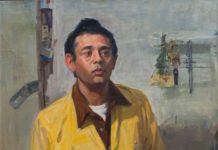by Cory Trépanier
An immense chasm. Intense hues. The sounds of the swirling wind and rushing of the Yellowstone River far below. Looking down, past the toes of my hiking boots into the perilously deep gorge of the canyon, I’m overcome by a powerful sense of smallness.

It was here, in Yellowstone National Park, that artist Thomas Moran found inspiration for “The Grand Canyon of the Yellowstone,” his iconic 7 x 12–foot oil painting created in 1872. I’d seen the piece at the Smithsonian American Art Museum in Washington DC, and to now behold the landscape that he depicted so masterfully was quite surreal.
The art Moran created during the Hayden Geological Survey a year earlier would be the driving force behind the Congress of his day establishing Yellowstone as the first national park in the world. Later, a mountain would be named in his honor.

Upon our arrival in Grand Teton National Park, which borders Yellowstone, the sun was setting, lighting up the sky with vivid magentas. I found myself starting a small painting en plein air, a view overlooking the Snake River to the massive Mount Moran. My personal ode to the great artist.

The next day my wife, Janet, and I trekked a little further to another Snake River view.
The backdrop this time was the Teton mountains, a scene majestically captured as a gelatine silver print in 1942 by Ansel Adams. His iconic black-and-white photograph “The Tetons and the Snake River” is one that I’ve used in presentations when discussing the role of art in preserving wild places. To be standing in the same place as Adams so many years later was truly moving. Throughout his lifetime and beyond, Adams’s influence as a landscape photographer and environmentalist would move millions of people to connect more deeply with the land, and in the process help protect it. And, who knows? He might even inspire alien life forms some day, as this image is part of the Voyager Golden Record on Voyager 1, a space vessel launched in 1977 that is currently 19 billion kilometers away from Earth.
Together, Adams and Moran have inspired many to connect with the wild places of this world and help conserve them. Their stories embody the powerful idea that an artist’s work can live on and change the world around them, even past their lifetimes.
Walking in the footsteps of Adams and Moran has been an artistic pilgrimage for me. One that has left me moved to find greater purpose in my own art in the years ahead.

Visit Cory Trépanier’s website at www.trepanieroriginals.com.





Great article and imagery!
I wonderful write up by Cory Trepanier and the videos are a perfect addition to his story. So proud to have Cory and Janet as fb friends. A truly talented Canadian artist with a purpose. Canada is proud of you. Well done.
Comments are closed.